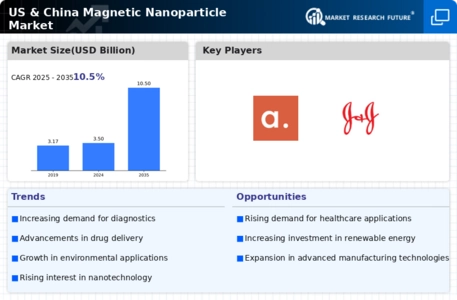Market Analysis
In-depth Analysis of US China Magnetic Nanoparticle Market Industry Landscape
The magnetic nanoparticle industry in the US and China is driven by complex factors that shape its competitive landscape and drive its growth dynamics. Over the last few years, there has been an upsurge of demand for magnetic nanoparticles in both countries as they are utilized across different fields such as healthcare, electronics, environmental remediation among others. A key factor driving this growth is the increasing focus on research and development in nanotechnology where governments and private entities are investing heavily.
In the US, there is a vibrant research and innovation ecosystem characterizing the magnetic nanoparticle market. The availability of leading academic institutions as well as research centers in conjunction with strong industry-academia linkage has propelled the emergence of cutting edge technologies around advanced Nano materials like Magnetic Nanoparticles (MNP). Furthermore, U.S health care sector has become a major consumer of these items particularly when it comes to some applications including Magnetic Resonance Imaging (MRI) scanners, drug delivery devices or cancer treatment procedures. Also fueling this growing demand is aging population together with increasing focus towards personalized medicine.
But, on the other hand, China’s magnetic nanoparticle market is experiencing rapid growth due to the country’s strategic focus on becoming a global leader in science and technology. The Chinese government’s ambitious plans and large investments in research and development are driving innovation and commercialization of products based on magnetic nanoparticles. Additionally, healthcare is also a major contributor to this market’s growth in China as a rising middle class coupled with increased awareness for healthcare drives adoption of sophisticated health care technologies.
Although both countries have similar market drivers, their competitive dynamics differ. In the United States, established players which are highly focused on research and development hold significant market shares. These players usually engage in partnerships with academic institutions or even form strategic alliances to have an upper hand over rivals. On the contrary, founded by vibrant start-up culture China’s magnetic nanoparticle market has been witnessing growth explosion. A fresh cohort of innovative companies is leveraging state support and venture capital funding to introduce novel technologies and goods which could potentially disrupt the status quo.
Trade tensions as well as geopolitical factors affect the dynamics of these markets between these two nations too. Political relationship instability affects regulatory environment; trade policies as well as company access within magnetite nanoparticles manufacturing industry. This gives rise to numerous geopolitical challenges that must be overcome by enterprises operating across both USA and PRC if they wish to successfully establish themselves on these markets.





Leave a Comment